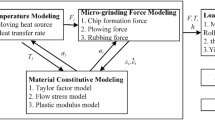Abstract
An estimating procedure for grinding-induced residual stress based on the indentation-fracture (IF) method was proposed by considering a nonuniform distribution of residual stress in the specimen depth. The proposed procedure was applied to gas pressure sintered and pressureless sintered silicon nitride ceramics, which were ground under different grinding conditions. The estimated residual stress was found to be compressive for both materials. The residual stress was dominantly affected by the grit size of the grinding wheel rather than the cutting depth. Although the dependency of the estimated residual stress on the grit size was different between the two materials, it was revealed that the estimated residual stress in both materials qualitatively corresponded with the stress measured by the x-ray diffraction method. In both materials, the bending strength was reasonably correlated with the estimated residual stress. It was elucidated that the proposed procedure was applicable to a relative evaluation of the grinding-induced residual stress in machined silicon nitride ceramics.
Similar content being viewed by others
References
D. Lewis III: Ceram. Bull., 1982, vol. 61 (11), pp. 1208–14.
H. Fessler, D.C. Fricker, and D.J. Godfrey: Ceram.-Perform. Appl., 1983, vol. 3, pp. 705–36.
M.W. Hawmann, P.H. Cohen, J.C. Conway, and R.N. Pangborn: J. Mater. Sci., 1985, vol. 20, pp. 482–90.
K. Tanaka, K. Suzuki, and Y. Yamamoto: Proc. Int. Conf. Residual Stresses, G. Beck, S. Denis, and A. Simon, eds., Elsevier Applied Science, New York, NY, 1989, pp. 15–26.
T. Hoshide, K. Okumura, and T. Inoue: J. Soc. Mater. Sci., Jpn., 1991, vol. 40 (449), pp. 217–33.
K. Suzuki and K. Tanaka: J. Soc. Mater. Sci., Jpn., 1991, vol. 40 (454), pp. 818–24.
D.W. Richerson: Modern Ceramic Engineering Properties, Processing, and Use in Design, Marcel Dekker, Inc., New York, NY, 1992.
D.B. Marshall and B.R. Lawn: J. Mater. Sci., 1979, vol. 14, pp. 2001–12.
D.B. Marshall, B.R. Lawn, and P. Chantikul: J. Mater. Sci., 1979, vol. 14, pp. 2225–35.
K. Zeng and D. Rowcliffe: “Experimental Measurement of Residual Stress Field around a Sharp Indentation in Glass,” Paper No. SIX-23-93, Apr. 1993, American Ceramic Society, Cincinnati, OH.
J. Salomonson and D. Rowcliffe: J. Am. Ceram. Soc., 1995, vol. 78 (1), pp. 173–77.
Y. Sakaida, S. Harada, and K. Tanaka: J. Soc. Mater. Sci., Jpn., 1993, vol. 42 (477), pp. 641–47.
B.R. Lawn: in Fracture Mechanics of Ceramics, R.C. Bradt, A.G. Evans, D.P.H. Hasselman, and F.F. Lange, eds., Plenum Press, New York, NY, 1983.
“Testing Methods for Flexural Strength (Modulus of Rupture) of High Performance Ceramics,” Japanese Industrial Standard JIS R 1607, Japanese Standards Association, Tokyo, 1995.
T. Hoshide and M. Masuda: Mater. Sci. Res. Int., 1995, vol. 1 (2), pp. 108–13.
“Testing Methods for Fracture Toughness of High Performance Ceramics,” Japanese Industrial Standard JIS R 1601, Japanese Standards Association, Tokyo, 1990.
Stress Intensity Factors Handbook, Y. Murakami, S. Aoki, N. Hasebe, Y. Itoh, H. Miyata, N. Miyazaki, H. Terada, K. Togho, M. Toya, and R. Yuuki, eds., Pergamon Press, Oxford, United Kingdom, 1987.
S. Harada: Report No. 98-A-419, Japan Fine Ceramics Center, Nagoya, Jan. 1999.
Author information
Authors and Affiliations
Rights and permissions
About this article
Cite this article
Hoshide, T., Abe, J. Grinding-induced residual stress estimation by indentation-fracture method in ground silicon nitrides. J. of Materi Eng and Perform 10, 586–591 (2001). https://doi.org/10.1361/105994901770344737
Received:
Issue Date:
DOI: https://doi.org/10.1361/105994901770344737




